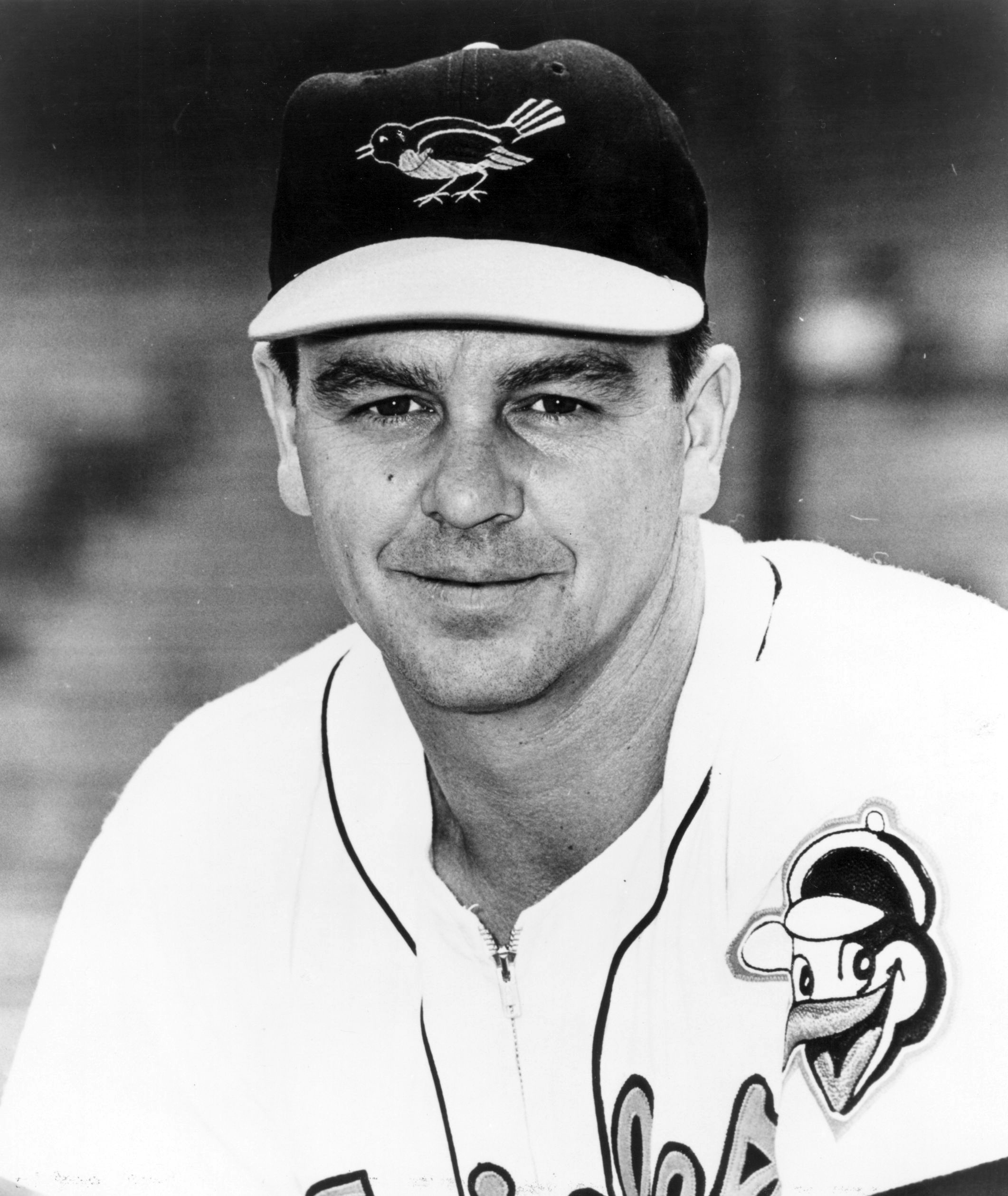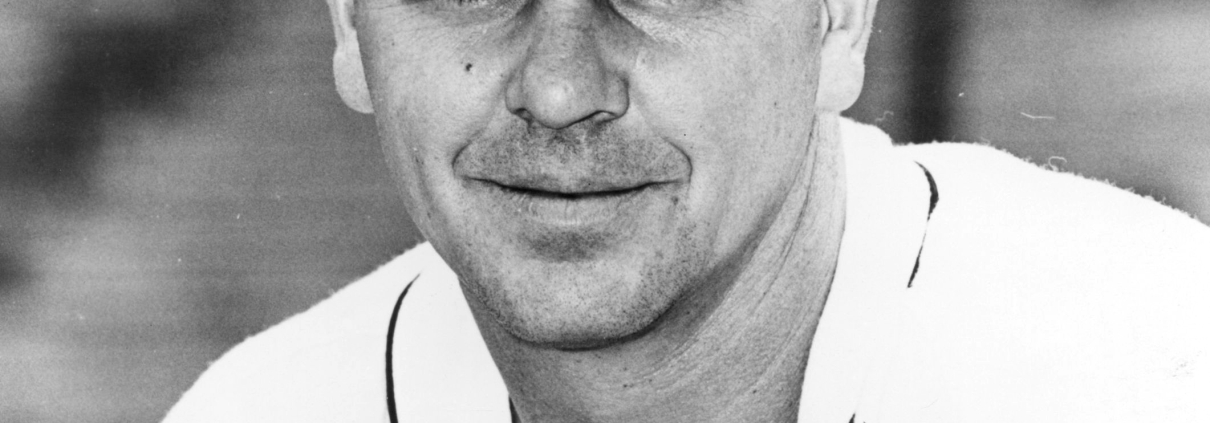May 18, 1957: Orioles’ Dick Williams homers to tie game at curfew
 On the morning of May 18, 1957, there were crowds of sports fans in downtown Baltimore. Most of them were in town for another historic sports event, not baseball – it was the day of the 81st running of the Preakness Stakes, the second leg of horse racing’s Triple Crown. The race would begin at 5:30 P.M. at Baltimore’s historic Pimlico Race Track. Kentucky Derby winner Iron Liege was the even-money favorite to win.1
On the morning of May 18, 1957, there were crowds of sports fans in downtown Baltimore. Most of them were in town for another historic sports event, not baseball – it was the day of the 81st running of the Preakness Stakes, the second leg of horse racing’s Triple Crown. The race would begin at 5:30 P.M. at Baltimore’s historic Pimlico Race Track. Kentucky Derby winner Iron Liege was the even-money favorite to win.1
To watch a baseball game that night, you would need to make the short trip to Memorial Stadium on 33rd Street, home of the Baltimore Orioles since 1954. The game would start at 7 P.M., not the customary 8 P.M. – the time moved up to allow time for the Chicago White Sox to catch a train to Boston immediately after the game.2 Both teams agreed to a 10:20 curfew – the game would end immediately at 10:20 P.M. according the home-plate umpire’s watch.3
The White Sox had won the Friday night game, 3-2. This was their sixth win in a row, keeping them in first place in the American League standings. For the seventh-place Orioles, it was their fifth loss in a row, following a disturbing pattern of blowing early leads against contending teams.4
In Chicago, this team hoped to finally reach the World Series, something it had not done since 1919. This was the time of the “Go-Go Sox” with speedsters Minnie Miñoso, Luis Aparicio, Jim Rivera, and Jim Landis. The Orioles were in some ways still the St Louis Browns, but hoping to improve with young stars like Brooks Robinson starting at third base and fan favorite Gus Triandos behind the plate – a city happy to again have a major-league baseball team to root for.
The game started mildly enough. The White Sox went down without a hit in the first inning. In the bottom of the first, George Kell singled to left field with one out and Bob Nieman walked, but both runners were stranded. Kell was an All-Star third baseman playing in his final year. (He hit over .300 12 times and won the AL batting title in 1949.) He had agreed to play one last year and mentor the young Brooks Robinson.
“When the Orioles broke camp, Brooks was listed as the starting third baseman with Kell slated for duty at first,” a Robinson biographer wrote. “Brooks’ elation at being in the starting lineup was short-lived, however. Two weeks into the 1957 season, hustling down the line after hitting a groundball to short, he saw the first baseman come off the bag to field a bad throw and swerved to avoid the sweep tag. As he did, his knee collapsed. He was carried to the clubhouse on a stretcher. Robinson was out for two months before the season really started.”5
The White Sox walked twice but lacked a hit in the second inning. The Orioles loaded the bases with none out in their half, but did not score.
Chicago starting pitcher Jack Harshman singled to right field with one out in the third inning, but did not score. In the Orioles’ third, there was controversy. After Gus Triandos flied out to center and Bob Nieman struck out, Tito Francona singled to right field. While on first base, “Earl Battey, the White Sox catcher, pegged poorly endeavoring to pick Francona off first base,” said a game account. “When Walt] Dropo, the rival first sacker, wheeled to pursue the errant throw into right field, he collided with Francona. There developed a torrid shoving match, with the Oriole runner forced to retreat to his original perch. Following a heated debate spearheaded by manager Paul Richards, Larry Napp, the umpire in chief, settled an apparent disagreement between two of his contemporaries. Napp’s decision, obstruction of Francona’s progress by Dropo, awarded Francona second base. This evoked wails of dissent from the White Sox.”6 Eventually a protest was filed. Dick Williams flied out to left to end the inning.
The fourth inning ended for the White Sox with Miñoso caught trying to steal third base on a strikeout. The Orioles did not score in their half of the fourth.
The White Sox stranded a walk in the fifth inning. In the bottom of the inning, the Orioles wasted leadoff singles by Kell and Triandos without scoring.
After the White Sox went 1-2-3 in the sixth, the Orioles broke through. Kell gave the home crowd something to cheer about when he doubled to center to score Jim Brideweser (single) and Billy Gardner (walk). Gus Triandos and Bob Nieman followed with singles to score Kell.
Then the White Sox countered in the seventh inning. After a leadoff single by Larry Doby, pinch-hitters Jim Rivera, Sherm Lollar, and Dave Philley all singled to score two runs. After striking out pinch-hitter Sammy Esposito, Connie Johnson walked pinch-hitter Ron Northey to load the bases. Nellie Fox’s sacrifice fly tied the game and Miñoso followed with a single to left to give the White Sox the lead. White Sox manager Al Lopez had used five pinch-hitters and two pinch-runners in the inning, not only giving his team the lead, but also wasting precious time, with the 10:20 curfew was approaching soon.7
The Orioles were retired 1-2-3 in the seventh as were the White Sox in the top of the eighth. In the bottom of the inning the Orioles’ Bob Boyd drew a pinch-hit leadoff walk and Triandos delivered a one-out single. After Bob Nieman was retired on a popup, Richards summoned left-handed reliever Paul LaPalme to face left-handed-hitting Tito Francona. LaPalme was off to a great start in 1957 and had pitched two innings to get the save in the previous night’s win.8 He struck out Francona to hold the lead.
The ninth inning was the crazy one. The White Sox were retired quickly in the top of the inning. With the curfew fast approaching, the Orioles’ Dick Williams ran to home plate. LaPalme’s first pitch was a ball. Williams fouled off the second pitch. The clock in center field said 10:19, but it was the umpire’s watch behind home plate that mattered.
As Al Lopez remembered 38 years later: “(LaPalme) had to make a pitch. … He couldn’t just stand there. The umpire would have called him on it. LaPalme’s instructions were not to give Williams anything good to hit. But he had that knuckler, sometimes it didn’t break at all. LaPalme’s first knuckleball was high, and Williams took it. He lined the next one foul down the left-field line. Napp looked at his watch but said nothing”9
On the third pitch, Williams hit a home run to left field. As soon as he touched home plate, the umpire called the game a 4-4 tie.10
“The third pitch was another knuckler, up some, but I swung and hit it out of the park,” Williams said.11
Two days later, the sports scribes were still talking about the game.
“Al Lopez, who is usually alert to what’s going on, was caught fast asleep Saturday night. … Sixty seconds of stalling could have brought the game to an end. LaPalme could have walked Williams or the bench could have called time for a conference with the pitcher,” commented a Baltimore Sun columnist.12
Another wrote: “The question was: Why did LaPalme give Williams a ball to hit? Why didn’t he walk him, throw the ball into the screen, re-tie his shoes, do anything to stall until the umpire Larry Napp signaled that it was 10:20?”13
“Kell said it was the screwiest thing he had ever seen, the fact they even pitched to me,” Williams said. “It wasn’t like I was a home run threat – it was my first one of the year. One or two pitches away from me and it would have been over.”14
“Lopez went bananas over the thing,” Triandos said. “The poor guy (LaPalme) was raked over the coals after that.”15
“After the game, Bob Maisel, who covered the game for the Sun, walked into the White Sox clubhouse to find Lopez still seething. ‘Al was in shock,’ Maisel said. ‘His mouth was hanging open. He couldn’t believe it. I saw him at the Hall of Fame a few years ago and needled him about it. Lopez said, ‘I’m still in shock.’”16
Brooks Robinson said, “The curfew game was one of the weirdest ever.”17
One might think that this would be Dick Williams’s most thrilling moment in baseball, but of course he was the manager of the Boston Red Sox in 1967 during their “Impossible Dream”season, and was later elected to the Hall of Fame.
Bold Ruler beat Iron Liege by two lengths in the Preakness – not the only unexpected ending in Baltimore that day.
Sources
In addition to the sources mentioned in the Notes, the author also relied on baseball-reference.com and retrosheet.org.
Notes
1 William Boniface, “Seven Slated to Start for Triple Crown’s Second Jewel,” Baltimore Sun, May 18, 1957.
2 Lou Hatter, “Blow in 9th Nips Curfew,” Baltimore Sun, May 19, 1957: 2D.
3 Irving Vaughan, “South Siders Seconds Shy from 7 In Row,” Chicago Tribune, May 19, 1957: 2, 1.
4 Bob Maisel, “Minoso Hits Double for Two in 8th,” Baltimore Sun, May 18, 1957: 13.
5 Doug Wilson, Brooks: The Biography of Brooks Robinson (New York: St. Martin’s Press, 2014), 69-70.
6 Hatter.
7 Vaughan.
8 Maisel.
9 Doug Brown, “Near Suspension and Utter Disbelief,” Baltimore Sun, June 8, 1995.
10 Hatter.
11 Brown.
12 Jesse A. Linthicum, “Sunlight on Sports – Al Lopez Caught Napping.” Baltimore Sun, May 20, 1957: 14.
13 Brown.
14 Linthicum.
15 Linthicum.
16 Linthicum.
17 Linthicum.
Additional Stats
Chicago White Sox 4
Baltimore Orioles 4
Memorial Stadium
Baltimore, MD
Box Score + PBP:
Corrections? Additions?
If you can help us improve this game story, contact us.


